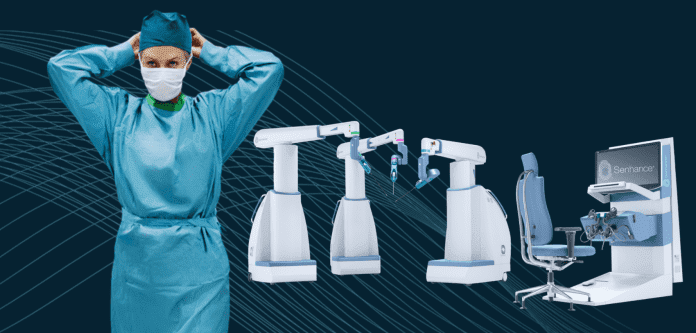What To Know
- The current features of the ISU enable machine vision-driven control of the camera for a surgeon by responding to commands and recognizing certain objects and locations in the surgical field, and allow a surgeon to change the visualized field of view using the movement of their instruments.
- ASXC), a medical device company that is digitizing the interface between the surgeon and patient to pioneer a new era of Performance-Guided Surgery™, today announced that it has received 510(k) clearance from the FDA for an expansion of machine vision capabilities on the previously cleared Intelligent Surgical Unit™ (ISU™).
Asensus Surgical, Inc. (NYSE American: ASXC), a medical device company that is digitizing the interface between the surgeon and patient to pioneer a new era of Performance-Guided Surgery™, today announced that it has received 510(k) clearance from the FDA for an expansion of machine vision capabilities on the previously cleared Intelligent Surgical Unit™ (ISU™). The ISU is utilized with the Company’s SenhanceⓇ Surgical System which enables Digital Laparoscopy.
“We are thrilled to have received FDA clearance for our next generation of augmented intelligence features on the ISU,” said Anthony Fernando, Asensus Surgical President and CEO. “The addition of these pioneering digital capabilities on our existing surgical platform provides real-time intraoperative digital tools to surgeons and underscores our commitment to delivering our vision for Performance-Guided Surgery. This is the latest example of our progress toward delivering on our Surgical Assurance Framework by unlocking the clinical intelligence necessary to enable consistently superior outcomes and a new standard of surgery.”
The current features of the ISU enable machine vision-driven control of the camera for a surgeon by responding to commands and recognizing certain objects and locations in the surgical field, and allow a surgeon to change the visualized field of view using the movement of their instruments. The newest ISU features expand upon these capabilities and introduce more advanced features including: 3D measurement, digital tagging, image enhancement, and enhanced camera control based on real-time data from anatomical structures while performing surgery. This will be the first time any of these features will be clinically available in soft-tissue abdominal surgery.
“This is a new era in digital surgery,” said Dr. Amit Trivedi, chair of surgery at Hackensack Meridian Health Pascack Valley Medical Center and an active user of the Senhance ISU with over one hundred cases completed utilizing the ISU. “The ability to intraoperatively measure with millimeter accuracy in real-time, place digital tags and know that the system keeps track of the instruments at all times are game-changers in surgery. I am very excited about these new features and the future innovations of the ISU’s digital technologies for surgeons.”
“Utilizing real-time 3D measurement tools would be valuable to evaluate margins and estimate defect sizing,” said Dr. Michael Cook of University Medical Center – New Orleans. “Digital tagging is a major advancement to pinpoint specific anatomical locations during the course of a complex operation that may be utilized as landmarks and teaching aides. Surgical robots have the potential to become decision support tools, and these new features help realize that potential.”
The 3D measurement feature enables the surgeon to use their instruments to designate points on the tissue floor to determine both straight-line distances as well as true topographic distances over the folds and recesses of the abdominal cavity. In traditional minimally invasive surgery, such measurements are estimated or require the use of a sterile measuring tape inside the abdominal cavity. Now 3D measurement allows for accurate readings to millimeter-level accuracy that can assist in various surgical tasks, such as the sizing of hernia mesh or the planning of a staple line. These measurement capabilities represent the first time surgeons have the ability to acquire accurate, real-time measurements without the need for additional tools.
Digital tagging introduces a new surgeon capability to make dynamic annotations on the live surgical camera view for real-time guidance and planning. Further, real-time underlying anatomy monitoring allows tags to persist through intraoperative camera movement. This has the potential to gain procedural efficiencies and delivers dynamic digital markers which preserves the tag locations while tissue is being manipulated.
Image enhancement dynamically adjusts the brightness and contrast of the surgical scene to provide a clear and consistent image, adaptively compensating for uneven illumination. Image enhancement facilitates high-quality video acquisition, which is a cornerstone of Performance-Guided Surgery. Because this feature is vision system agnostic, this benefit can be realized with all vision systems that are compatible with Senhance.
Enhanced camera control builds on existing methods of instrument-based camera control and directs camera positioning based on the tracked location of multiple instruments within the scene and allows for automatic adjustment of pan and zoom simultaneously to maintain visualization of the instruments. Always maintaining visualization of instruments in the field of view is a best practice for performing safe surgery.
The clearance of these expanded augmented intelligence features demonstrates the Company’s commitment to delivering on the promise of Performance-Guided Surgery. The Company believes these additional features will provide meaningful support for surgeons across a range of specialties and procedures. Additionally, the foundational elements of these features will enable the Company to continue introducing novel augmented intelligence features in the future by leveraging the vast capabilities and potential of the ISU.

